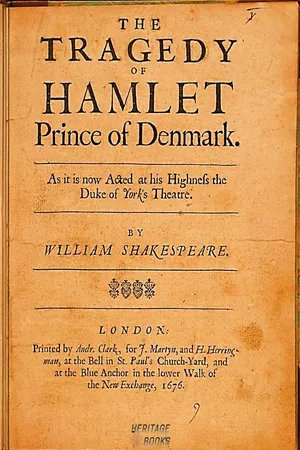Hamlet
About this book
The Tragedy of Hamlet, Prince of Denmark, often shortened to Hamlet, is a tragedy written by William Shakespeare sometime between 1599 and 1602.
It may be audacious even to attempt a definition of his greatness, but it is not so difficult to describe the gifts that enabled him to create imaginative visions of pathos and mirth that, whether read or witnessed in the theatre, fill the mind and linger there. He is a writer of great intellectual rapidity, perceptiveness, and poetic power. Other writers have had these qualities, but with Shakespeare the keenness of mind was applied not to abstruse or remote subjects but to human beings and their complete range of emotions and conflicts. Other writers have applied their keenness of mind in this way, but Shakespeare is astonishingly clever with words and images, so that his mental energy, when applied to intelligible human situations, finds full and memorable expression, convincing and imaginatively stimulating. As if this were not enough, the art form into which his creative energies went was not remote and bookish but involved the vivid stage impersonation of human beings, commanding sympathy and inviting vicarious participation. Thus, Shakespeare’s merits can survive translation into other languages and into cultures remote from that of Elizabethan England.
Although the amount of factual knowledge available about Shakespeare is surprisingly large for one of his station in life, many find it a little disappointing, for it is mostly gleaned from documents of an official character. Dates of baptisms, marriages, deaths, and burials; wills, conveyances, legal processes, and payments by the court—these are the dusty details. There are, however, many contemporary allusions to him as a writer, and these add a reasonable amount of flesh and blood to the biographical skeleton.
For a chronological listing of Shakespeare’s plays, see below. Despite much scholarly argument, it is often impossible to date a given play precisely. But there is a general consensus, especially for plays written in 1588–1601, in 1605–07, and from 1609 onward. The dates of composition used here are based on external and internal evidence, on general stylistic and thematic considerations, and on the observation that an output of no more than two plays a year seems to have been established in those periods when dating is rather clearer than others.
Frequently asked questions
- Essential is ideal for learners and professionals who enjoy exploring a wide range of subjects. Access the Essential Library with 800,000+ trusted titles and best-sellers across business, personal growth, and the humanities. Includes unlimited reading time and Standard Read Aloud voice.
- Complete: Perfect for advanced learners and researchers needing full, unrestricted access. Unlock 1.4M+ books across hundreds of subjects, including academic and specialized titles. The Complete Plan also includes advanced features like Premium Read Aloud and Research Assistant.
Please note we cannot support devices running on iOS 13 and Android 7 or earlier. Learn more about using the app.
Information
Table of contents
- (Untitled)
- (Untitled)
- Introduction
